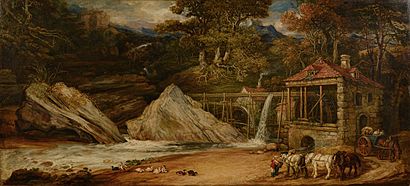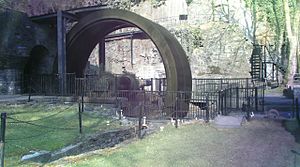An Overshot Mill in Aberdulais, Wales facts for kids
Quick facts for kids An Overshot Mill in Aberdulais, Wales |
|
|---|---|
 |
|
| Artist | James Ward |
| Year | 1847 |
| Medium | Oil on canvas |
| Dimensions | 63 cm × 137 cm (25 in × 54 in) |
| Location | National Library of Wales, Aberystwyth |
An Overshot Mill in Aberdulais, Wales is a beautiful oil painting from 1847. It was created by a British artist named James Ward. You can find this painting today at the National Library of Wales.
This artwork shows a special kind of water mill. It's located where the Dulais river meets the Neath river, close to the famous Aberdulais Falls. This spot was so important and scenic that another famous artist, J. M. W. Turner, also painted it!
Contents
Discovering the Aberdulais Mill Painting
This painting by James Ward captures a moment in time from 1847. It shows a busy water mill in a beautiful Welsh landscape. The mill used the power of flowing water to do work.
What is an Overshot Mill?
An overshot mill uses a large waterwheel. The water from a river or stream flows over the top of the wheel. As the water falls, its weight pushes the wheel around. This spinning motion creates power. This power was used for many things, like grinding grain into flour or sawing wood.
About the Artist: James Ward
James Ward was a British painter who lived from 1769 to 1859. He was known for his amazing landscape paintings. He also painted animals and historical scenes. Ward often captured the beauty of nature and the way people used it. His works help us see what the world looked like long ago.
The Story of Aberdulais Falls
Aberdulais Falls is a waterfall in Wales. It's a powerful natural feature. For hundreds of years, people have used the energy of the falling water here. The mill in Ward's painting is just one example.
Why Mills Were Important
Water mills were like the factories of their time. They used natural power to help people. They were essential for making food and other goods. The mill at Aberdulais played a big part in the local community. It shows how people used nature's power before electricity was common.
Images for kids




